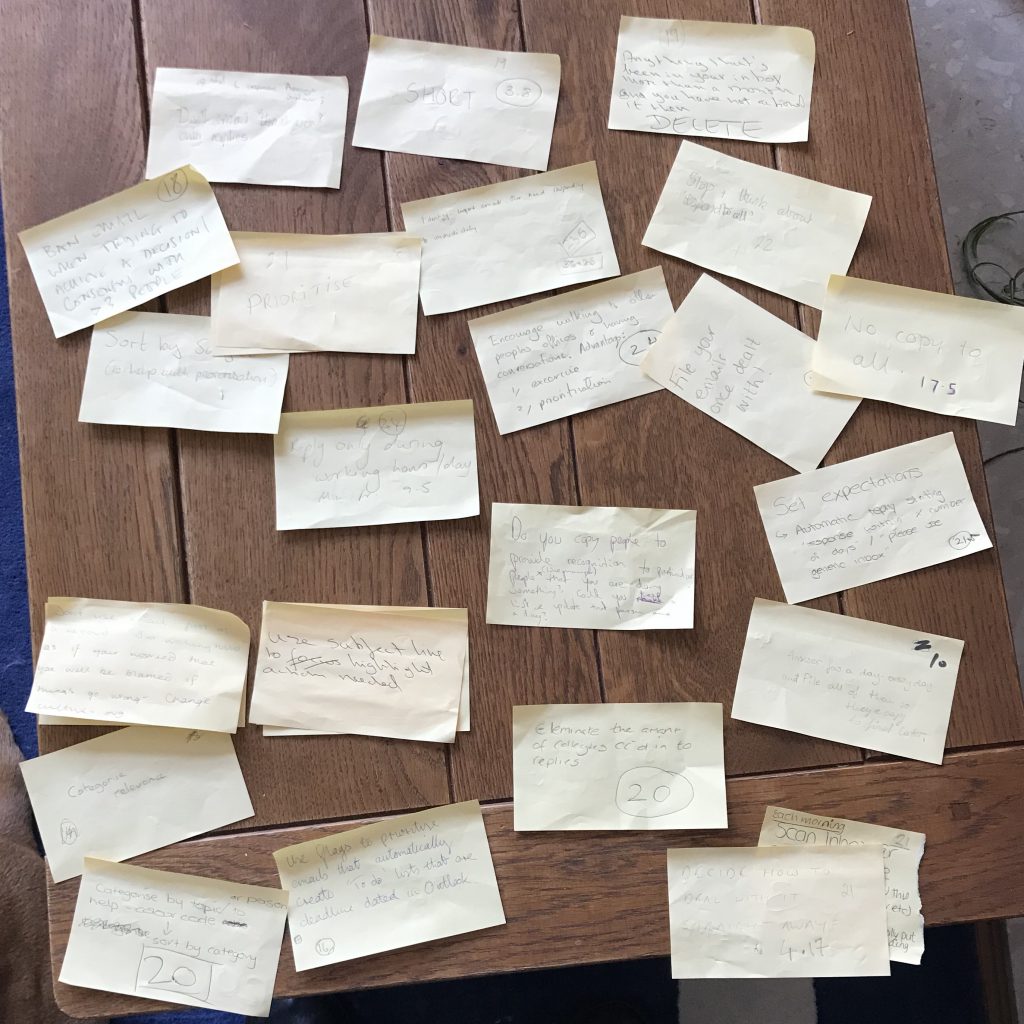Using Liberating Structures to discuss email
28 June 2019Yesterday, during the Centre for Medical Education Staff Development Day, we discussed email. We used two Liberating Structures: 25/10 Crowd Sourcing to generate ideas and then 15% Solutions to identify which of these solutions we could use immediately. It was a busy, productive, enjoyable 50 minutes.

During the Crowd Sourcing, we generated and evaluated 42 different ideas on Post-It notes in about 15 minutes – really efficient. We also danced, well more shuffled, around the room to music. Staff chatted and generally seemed to be having a good time. The full list of ideas is here.

The top idea (score 25) was “Talk more i.e. pick up the phone” and 8 other ideas were very similar. One of my favourite ideas was: “Encourage walking to other people’s offices & having conversations. Advantages: 1. exercise 2. prioritisation”. I really liked that the creator added these advantages. Given the hazards of sitting down all the time, I really like the exercise advantage.

Another important theme concerned prioritising, categorising and filing. The second best score was for the idea of “File your emails once dealt with!” The value of flags, colours and folders was discussed.

Identifying 15% Solutions, we tried to look at ideas that we could implement immediately without any additional cost. Sensible subject lines, reducing the “thank you” emails and avoiding “Reply to all” seemed worthwhile here.
To summarise the top tips for C4ME look like:
- Use phone or see in person
- Prioritise, categorise & file
- Try to use sensible subject lines
- Avoid “Reply to all”
- Limit hours – attending to email and sending email
The point about limiting hours was two-fold – one was about getting the most important things done rather than just doing emails while the other was really about sending emails out of hours. For flexible working, only sending emails between 9am and 5pm can be restrictive. However, one colleague mentioned that they received six emails over the weekend from the same colleague when they logged in on Monday morning – perhaps these could be one email? Also, if people are on holidays and have an “Out of Office” message, it’s probably best not to email them if possible.
The out of hours emails can be a cultural thing as shown on twitter recently.

I don’t know if there can ever be a reason to email a student in the middle of the night… my instinct is no.
All in all, plenty of good suggestions, lots of learning and a good fun 50 minutes. I’m pleased 🙂
Some resources
- An email charter
- College of Arts, Humanities and Social Sciences: Email Communications and Meetings policy (intranet link)
- A book about Deep Work recommended by Ceri Evans and a blog post about Deep Work too – looks interesting.
- June 2024
- May 2023
- September 2022
- August 2022
- February 2022
- January 2022
- November 2021
- November 2020
- September 2020
- July 2020
- June 2020
- May 2020
- November 2019
- June 2019
- May 2019
- December 2018
- June 2018
- November 2017
- June 2017
- July 2016
- June 2016
- April 2016
- October 2015
- July 2015
- April 2015
- March 2015
- February 2015
- January 2015
- November 2014
- October 2014
- August 2014
- March 2014
- November 2013
- August 2013
- July 2013